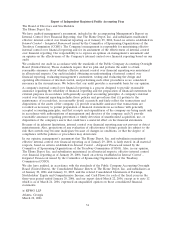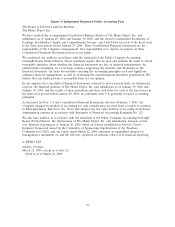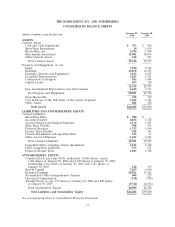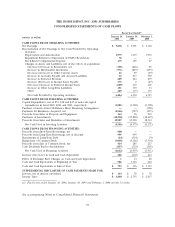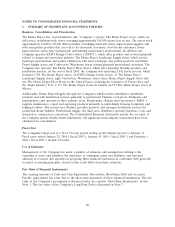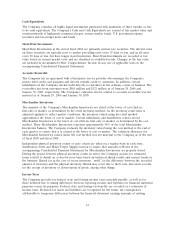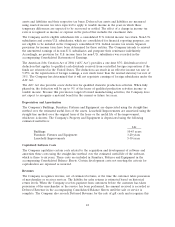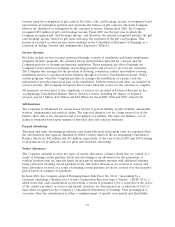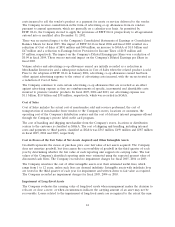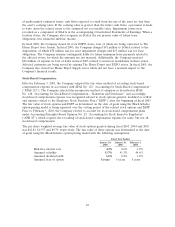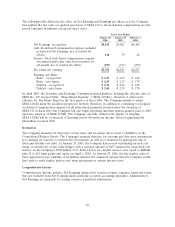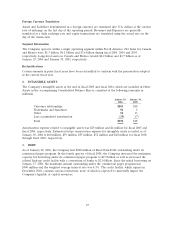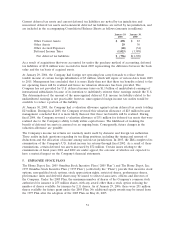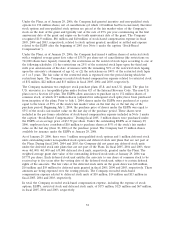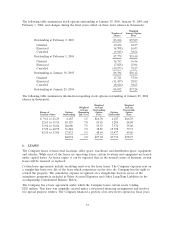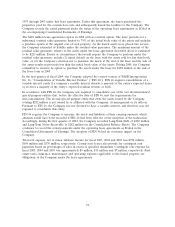Home Depot 2005 Annual Report Download - page 56
Download and view the complete annual report
Please find page 56 of the 2005 Home Depot annual report below. You can navigate through the pages in the report by either clicking on the pages listed below, or by using the keyword search tool below to find specific information within the annual report.costs incurred to sell the vendor’s product or a payment for assets or services delivered to the vendor.
The Company receives consideration in the form of advertising co-op allowances from its vendors
pursuant to annual agreements, which are generally on a calendar year basis. As permitted by
EITF 02-16, the Company elected to apply the provisions of EITF 02-16 prospectively to all agreements
entered into or modified after December 31, 2002.
There was no material impact to the Company’s Consolidated Statements of Earnings or Consolidated
Balance Sheets for fiscal 2005. The impact of EITF 02-16 in fiscal 2004 and fiscal 2003 resulted in a
reduction of Cost of Sales of $891 million and $40 million, an increase to SG&A of $1.0 billion and
$47 million and a reduction to Earnings before Provision for Income Taxes of $158 million and
$7 million, respectively. The impact on the Company’s Diluted Earnings per Share was a reduction of
$0.04 in fiscal 2004. There was no material impact on the Company’s Diluted Earnings per Share in
fiscal 2003.
Volume rebates and advertising co-op allowances earned are initially recorded as a reduction in
Merchandise Inventories and a subsequent reduction in Cost of Sales when the related product is sold.
Prior to the adoption of EITF 02-16 in January 2004, advertising co-op allowances earned had been
offset against advertising expense to the extent of advertising costs incurred, with the excess treated as
a reduction of Cost of Sales.
The Company continues to earn certain advertising co-op allowances that are recorded as an offset
against advertising expense as they are reimbursements of specific, incremental and identifiable costs
incurred to promote vendors’ products. In fiscal 2005, 2004 and 2003, net advertising expense was
$1.1 billion, $1.0 billion and $58 million, respectively, which was recorded in SG&A.
Cost of Sales
Cost of Sales includes the actual cost of merchandise sold and services performed, the cost of
transportation of merchandise from vendors to the Company’s stores, locations or customers, the
operating cost of the Company’s distribution centers and the cost of deferred interest programs offered
through the Company’s private label credit card program.
The cost of handling and shipping merchandise from the Company’s stores, locations or distribution
centers to the customer is classified as SG&A. The cost of shipping and handling, including internal
costs and payments to third parties, classified as SG&A was $563 million, $499 million and $387 million
in fiscal 2005, 2004 and 2003, respectively.
Cost in Excess of the Fair Value of Net Assets Acquired and Other Intangible Assets
Goodwill represents the excess of purchase price over fair value of net assets acquired. The Company
does not amortize goodwill, but does assess the recoverability of goodwill in the third quarter of each
year by determining whether the fair value of each reporting unit supports its carrying value. The fair
values of the Company’s identified reporting units were estimated using the expected present value of
discounted cash flows. The Company recorded no impairment charges for fiscal 2005, 2004 or 2003.
The Company amortizes the cost of other intangible assets over their estimated useful lives, which
range from 1 to 12 years, unless such lives are deemed indefinite. Intangible assets with indefinite lives
are tested in the third quarter of each year for impairment and written down to fair value as required.
The Company recorded no impairment charges for fiscal 2005, 2004 or 2003.
Impairment of Long-Lived Assets
The Company evaluates the carrying value of long-lived assets when management makes the decision to
relocate or close a store, or when circumstances indicate the carrying amount of an asset may not be
recoverable. Losses related to the impairment of long-lived assets are recognized to the extent the sum
44


